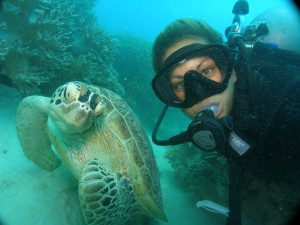Gliding effortlessly in the vast ocean wilderness, riding the currents from one reef to another, she scours the sandy bottom for tid-bits of algae to snack on before she surfaces, taking a few big gulps of air and then retreating down to nestle herself comfortably in amongst the soft corals of a shallow lagoon for a quick nap. The Green Sea Turtle is the most commonly encountered sea turtle at beaches and reefs around the world, and has a deep connection to many different cultures and peoples. In Chinese mythology, she represents wisdom. In New Zealand, Maori sailors would carve turtles into their maka (canoes) as a connection to their homeland, recognising that Green Sea Turtles will swim great distances to return to their breeding grounds. Hawaiian legends tell of Kauila, the mythical mother of all turtles, who would change herself into a girl to watch over children playing at Punalu’u Beach on the Big Island.
What is it about turtles that invoke such romantic, idealised images? Thousands of visitors from around the world come to the Great Barrier Reef each year, scuba diving and snorkelling, hoping to see a turtle. Catch some dive instructors in just their board shorts or bikinis, and chances are you’ll see a turtle incorporated in an elaborate tribal tattoo. Even visitors who watch from above deck marvel and snap photos when the turtles come to the surface for a breath. What humans have learned about turtles, and what we still have to learn, is the driving force behind conservation efforts to ensure that this iconic species survives for future generations to enjoy. We know they’re old; the earliest sea turtle fossils date back 150 million years. We know they travel great distances, sometimes thousands of kilometres, between their breeding and feeding grounds, to mate and lay eggs. We know that females will lay 50 to 100 eggs in a carefully dug nest, cover the eggs with a layer of sand, and then abandon them, leaving them at the mercy of the sun and elements. And we know they’re disappearing.
Conservation biologists use the International Union for Conservation of Nature’s Red List, where “endangered” is the second most severe conservation status for wild populations (following critically endangered) to describe species likely to become extinct; Green Sea Turtles are on that list, and for a variety of reasons. Large resorts and housing developments along desirable coastlines have meant a decline in breeding grounds. Introduced species such as dogs, cats, wild pigs, and foxes dig up nests around the world, and can destroy entire breeding seasons in certain areas. Green Sea Turtles’ shells, illegal to trade under the United Nation’s Convention on International Trade in Endangered Species of Wild Fauna and Flora (CITES) are highly prized decorative ornaments around the world, with poachers getting huge payoffs for quality specimens.
But there is good news. As governments and conservation groups around the world rally to protect breeding habitats, ban indiscriminate fishing methods (of which Green Sea turtles are often by-catch), and crack down on poaching, populations have seen a decrease in the rate of decline; in some places, populations are even recovering. But more is needed to ensure these iconic creatures remain in the ocean‘s ecosystem, and not just as wood carvings, photographs and memories. To do your part, only travel with responsible reef operators and refrain from handling all wildlife, including turtles. Write to your elected officials asking for more protection of marine ecosystems. And lastly, decrease your use of plastic bags, which all species of turtle can mistake for food and die trying to eat.

